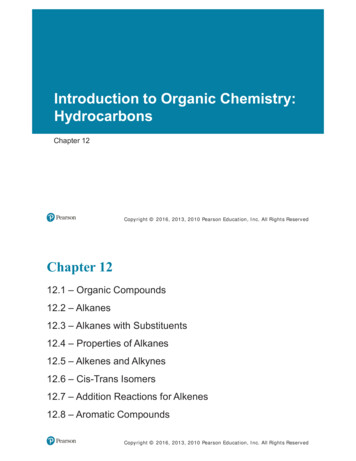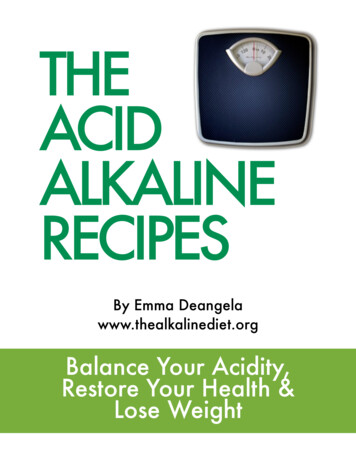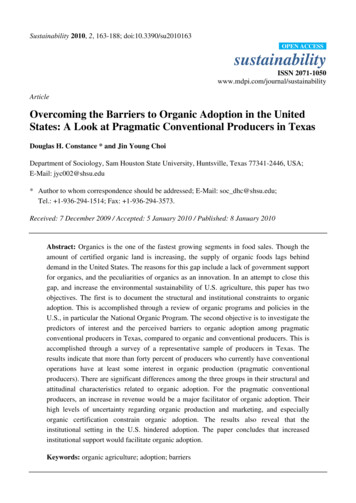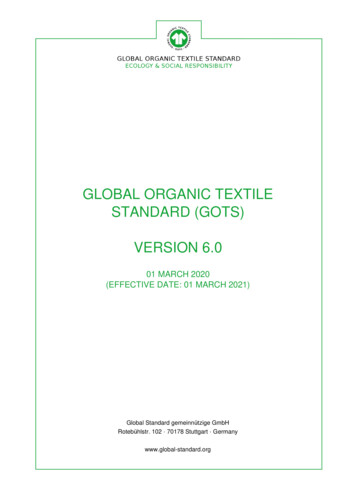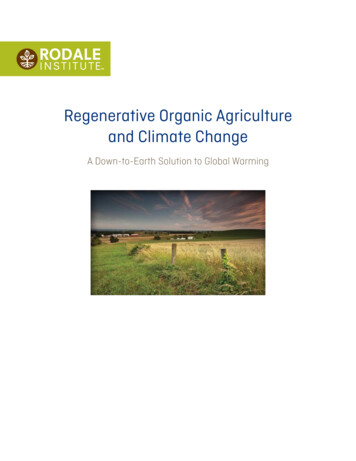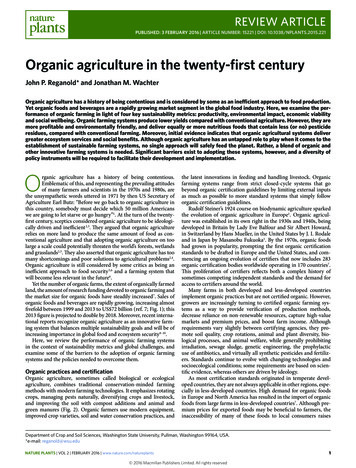
Transcription
REVIEW ARTICLEPUBLISHED: 3 FEBRUARY 2016! ARTICLE NUMBER: 15221 DOI: 10.1038/NPLANTS.2015.221Organic agriculture in the twenty-first centuryJohn P. Reganold* and Jonathan M. WachterOrganic agriculture has a history of being contentious and is considered by some as an inefficient approach to food production.Yet organic foods and beverages are a rapidly growing market segment in the global food industry. Here, we examine the performance of organic farming in light of four key sustainability metrics: productivity, environmental impact, economic viabilityand social wellbeing. Organic farming systems produce lower yields compared with conventional agriculture. However, they aremore profitable and environmentally friendly, and deliver equally or more nutritious foods that contain less (or no) pesticideresidues, compared with conventional farming. Moreover, initial evidence indicates that organic agricultural systems delivergreater ecosystem services and social benefits. Although organic agriculture has an untapped role to play when it comes to theestablishment of sustainable farming systems, no single approach will safely feed the planet. Rather, a blend of organic andother innovative farming systems is needed. Significant barriers exist to adopting these systems, however, and a diversity ofpolicy instruments will be required to facilitate their development and implementation.Organic agriculture has a history of being contentious.Emblematic of this, and representing the prevailing attitudesof many farmers and scientists in the 1970s and 1980s, arethe unsympathetic words uttered in 1971 by then US Secretary ofAgriculture Earl Butz: “Before we go back to organic agriculture inthis country, somebody must decide which 50 million Americanswe are going to let starve or go hungry”1. At the turn of the twentyfirst century, sceptics considered organic agriculture to be ideologically driven and inefficient 2,3. They argued that organic agriculturerelies on more land to produce the same amount of food as conventional agriculture and that adopting organic agriculture on toolarge a scale could potentially threaten the world’s forests, wetlandsand grasslands2,3. They also asserted that organic agriculture has toomany shortcomings and poor solutions to agricultural problems2,4.Organic agriculture is still considered by some critics as being aninefficient approach to food security 5,6 and a farming system thatwill become less relevant in the future6.Yet the number of organic farms, the extent of organically farmedland, the amount of research funding devoted to organic farming andthe market size for organic foods have steadily increased7. Sales oforganic foods and beverages are rapidly growing, increasing almostfivefold between 1999 and 2013 to US 72 billion (ref. 7; Fig. 1); this2013 figure is projected to double by 2018. Moreover, recent international reports recognize organic agriculture as an innovative farming system that balances multiple sustainability goals and will be ofincreasing importance in global food and ecosystem security 8–10.Here, we review the performance of organic farming systemsin the context of sustainability metrics and global challenges, andexamine some of the barriers to the adoption of organic farmingsystems and the policies needed to overcome them.Organic practices and certificationOrganic agriculture, sometimes called biological or ecologicalagriculture, combines traditional conservation-minded farmingmethods with modern farming technologies. It emphasizes rotatingcrops, managing pests naturally, diversifying crops and livestock,and improving the soil with compost additions and animal andgreen manures (Fig. 2). Organic farmers use modern equipment,improved crop varieties, soil and water conservation practices, andthe latest innovations in feeding and handling livestock. Organicfarming systems range from strict closed-cycle systems that gobeyond organic certification guidelines by limiting external inputsas much as possible to more standard systems that simply followorganic certification guidelines.Rudolf Steiner’s 1924 course on biodynamic agriculture sparkedthe evolution of organic agriculture in Europe1. Organic agriculture was established in its own right in the 1930s and 1940s, beingdeveloped in Britain by Lady Eve Balfour and Sir Albert Howard,in Switzerland by Hans Mueller, in the United States by J. I. Rodaleand in Japan by Masanobu Fukuoka1. By the 1970s, organic foodshad grown in popularity, prompting the first organic certificationstandards to be drafted in Europe and the United States, and commencing an ongoing evolution of certifiers that now includes 283organic certification bodies worldwide operating in 170 countries7.This proliferation of certifiers reflects both a complex history ofsometimes competing independent standards and the demand foraccess to certifiers around the world.Many farms in both developed and less-developed countriesimplement organic practices but are not certified organic. However,growers are increasingly turning to certified organic farming systems as a way to provide verification of production methods,decrease reliance on non-renewable resources, capture high-valuemarkets and premium prices, and boost farm income. Althoughrequirements vary slightly between certifying agencies, they promote soil quality, crop rotations, animal and plant diversity, biological processes, and animal welfare, while generally prohibitingirradiation, sewage sludge, genetic engineering, the prophylacticuse of antibiotics, and virtually all synthetic pesticides and fertilizers. Standards continue to evolve with changing technologies andsocioecological conditions; some requirements are based on scientific evidence, whereas others are driven by ideology.As most certification standards originated in temperate developed countries, they are not always applicable in other regions, especially in less-developed countries. High demand for organic foodsin Europe and North America has resulted in the import of organicfoods from large farms in less-developed countries7. Although premium prices for exported foods may be beneficial to farmers, theinaccessibility of many of these foods to local consumers raisesDepartment of Crop and Soil Sciences, Washington State University, Pullman, Washington 99164, USA.*e-mail: reganold@wsu.eduNATURE PLANTS VOL 2 FEBRUARY 2016 www.nature.com/natureplants 2016 Macmillan Publishers Limited. All rights reserved1
REVIEW ARTICLE45Sales, otherSales, EuropeSales, North AmericaGlobal sales, no breakdownOrganic land 8Food, fibre and fuel forhuman and livestock useand consumption40Organic land area (ha 106)Sales of organic food (US billion)80NATURE PLANTS DOI: 10.1038/NPLANTS.2015.221Physical rop re 1 Annual global market for organic foods and land area of organicproduction. Increasing sales of organic food in nominal billions of USdollars (bars), broken down by contributions from North America (red),Europe (green) and the rest of the world (orange), and increasing totalglobal land area under organic production in millions of hectares (blueline)7,96–98. European and North American contributions were not availablefor the years 1998 through 2000, shown in grey.Supplementarylime, organicfertilizers andcompostCrop andanimalhealthBiologicallyactive soilSpecies, varietyand managementTemporal andspatial patternsDiversespeciesbalanceHedges,marginsand otherhabitat areasSustainability of organic agricultureFigure 2 Organic management practices. The complex interactionsamong structural factors and tactical management strategies on adiversified organic farm producing food, fibre and fuel for human andlivestock use and consumption. Structural factors, represented bycircles, are the foundation of organic management, with diverse crop andlivestock rotations at the centre. Tactical management decisions are usedto supplement the structural factors and include the use of: biologicalcontrols; supplementary lime, organic fertilizers and compost; hedges,margins and other habitat areas; species, variety and breed selection;temporal and spatial patterns; and physical weed management. Figureadapted from ref. 99, 2001 Elsevier.Production. Production includes crop and animal yield and theirquality. Numerous individual studies have compared yield differences between organic and conventional systems. These data havebeen synthesized in several meta-analyses or reviews; according to these studies, yield averages are 8 to 25% lower in organicsystems15–19. However, with certain crops, growing conditions andmanagement practices, organic systems come closer to matchingconventional systems in terms of yields. According to one suchsynthesis study, the best yielding organically grown crops or cropgroups are rice, soybeans, corn and grass-clover, which yield 6 to11% less than conventional systems; the lowest yielding are fruitsand wheat, which yield 28 and 27% less, respectively 17. Anothermeta-analysis found fruits, soybeans and oilseed to be the highestyielding organic crops, and wheat and vegetables the lowest, yielding 37 and 33% less than conventional systems respectively 18. Incases where organic crop rotations depend on green manure crops,food production over the whole rotation may be lower than one-toone crop yield comparisons suggest 17.Although meta-analysis is a great tool that can describe broadpatterns not immediately visible in primary field research19,20, itmust also be treated with caution, because no single farming system or practice works best everywhere. Still, these studies15–19 givestrength to the argument that adoption of organic agricultureunder agroecological conditions where it performs best may closethe yield gap between organic and conventional systems. Undersevere drought conditions, which are expected to increase withclimate change in many areas, organically managed farms havefrequently been shown to produce higher yields than their conventional counterparts21,22, due to the higher water-holding capacity oforganically farmed soils23. In addition, improvements in management techniques and crop varieties for organic systems may alsoclose this yield gap. For example, direct selection of wheat cultivarsin organic systems has resulted in improved yields in organic systems when compared with indirect selection of wheat cultivars inconventional systems24.Whereas organic systems yield less food, organic foods havesignificantly less to no synthetic pesticide residues compared withconventionally produced foods25–28. Studies have also found thatchildren who eat conventionally produced foods have significantlyhigher levels of organophosphate pesticide metabolites in theirurine than children who eat organically produced foods29,30. In 2012,the American Academy of Pediatrics reported that an organic dietreduces children’s exposure to pesticides, and provided resourcesfor parents seeking guidance on which foods tend to have the highest pesticide residues31. Although these data show that organic foodsquestions about food security and social equity. Participatory guarantee systems, which rely on local stakeholder verification, haveemerged as a more locally focused alternative to traditional certification7, and could lead to the development of more locally relevantvisions for the production and consumption of organic foods.About 38% of Earth’s land cover is occupied by agriculture11.Although agriculture provides growing supplies of food and otherproducts, it is a major contributor to greenhouse gases, biodiversityloss, agrochemical pollution and soil degradation12–14. Most of theseenvironmental consequences come from arable land, which comprises around 12% of the land cover 11. The challenge of feeding agrowing population expected to reach 9 to 10 billion people by 2050while protecting the environment is daunting. Adopting truly sustainable farming systems on a wide scale is our best opportunity formeeting this grand challenge and ensuring future food and ecosystem security. Concerns about the unsustainability of conventionalagriculture have promoted interest in other farming systems, suchas organic, integrated and conservation agriculture8–10.According to a US National Academy of Sciences report 10, anyfarm, be it organic or conventional, can only be deemed sustainable if it produces adequate amounts of high-quality food, enhancesthe natural-resource base and environment, is financially viable,and contributes to the wellbeing of farmers and their communities. With the rise of organic farming in the past two decades, hundreds of research studies comparing different aspects of organic andconventional farming systems have been published. This sectionfocuses on assessing such comparison studies across these four sustainability areas.2NATURE PLANTS VOL 2 FEBRUARY 2016 www.nature.com/natureplants 2016 Macmillan Publishers Limited. All rights reserved
REVIEW ARTICLENATURE PLANTS DOI: 10.1038/NPLANTS.2015.221aN added inmanure andamendmentsGaseousN lossSoilorganic NN fixedby lightningAtmosphericN depositionFertilizer NadditionMineralizationN loss throughdenitrificationVolatile N lossduring senescenceN added inmanure andamendmentsN fixedby lightningAtmosphericN depositionFertilizer NadditionGaseousN lossBiologicalN fixationN loss throughdenitrificationVolatile N lossduring senescenceBiologicalN fixationMineralizationSoilmineral NImmobilizationCrop NCrop NuptakeN exportin harvestCrop residue N returnErosion N lossbN runoffSoilorganic NImmobilizationSoilmineral NCrop NCrop NuptakeN exportin harvestCrop residue N returnN leachingErosion N lossN runoffN leachingFigure 3 Hypothetical nitrogen stocks and flows of two contrasting cropping systems. a,b, Cropping systems relying mainly on mineral nitrogen inputs(a) have relatively higher nitrogen losses to air and water than cropping systems with emphasis on biological N fixation, manure and other organic matteramendments, cover crops and perennial crops, and low reliance on mineral N fertilizer, such as organic and integrated systems (b). The width of thearrows is relative to the size of the nitrogen flux; boxes representing nitrogen stocks are not scaled to the pool size. Figure adapted from ref. 100, 2015The National Academies100. Arrows represent nitrogen inputs (green), losses (orange) and transformations (blue).may present some clear advantages when it comes to synthetic pesticide residues, the human health impacts of pesticide exposurefrom food are not clear 26, and organically certified pesticides needto be better identified and taken into account 28.At least 15 reviews or meta-analyses26,27,32–44 of the scientificliterature comparing the nutrition of organic and conventionalfoods have been published in the past 15 years. Twelve of thesestudies27,32–34,36–39,41–44 found some evidence of organic food beingmore nutritious (for instance, having higher concentrations ofvitamin C, total antioxidants and total omega-3 fatty acids, andhigher omega-3 to -6 ratios). Whether or not these are nutritionallymeaningful differences continues to be debated26,43. The other threestudies26,35,40 concluded that there were no consistent nutritional differences between organic and conventional foods. However, one ofthe three studies found that conventional chicken and pork had a33% higher risk for contamination with antibiotic-resistant bacteriacompared with organic alternatives26.Environment. Reviews and meta-analyses generally support theperception that organic farming systems are more environmentallyfriendly than conventional farming systems45–58. For example, suchaggregate studies have found that organic farming systems consistently have greater soil carbon levels, better soil quality and lesssoil erosion compared with conventional systems45–51. In addition,organic farms generally have more plant diversity, greater faunaldiversity (insects, soil fauna and microbes, birds) and often morehabitat and landscape diversity 46–55. Most functional groups, such asherbivores, pollinators, predators and producers (plants), are morediverse in organic farming systems51–53. Moreover, in a study covering eight western and eastern European countries, insecticidesand fungicides had consistently negative effects on biodiversity,with insecticides also reducing the biological control potential infarming systems56.As organic agriculture uses virtually no synthetic pesticides,there is little to no risk of synthetic pesticide pollution of groundand surface waters46. With respect to nitrate and phosphorous leaching and greenhouse gas emissions, organic farming systems scorebetter than conventional farming when expressed per unit production area46,49,51,57,58; however, given the lower land-use efficiency oforganic farming in developed countries, this positive effect is lesspronounced and in some cases reversed when expressed per unitproduct 49,57,58. In a meta-analysis of environmental quality parameters, organic farms were found to have lower nitrate leaching,nitrous oxide emissions and ammonia emissions per unit of fieldarea, but higher leaching and emissions per unit product 48. Severedegradation of freshwater and marine ecosystems around the worldis linked to excessive use of nitrogen and phosphorous fertilizers12,59, leading to eutrophication of freshwater and the productionof hypoxic zones in coastal waters. Lower nutrient pollution fromorganic compared with conventional systems can be illustrated bydifferences in their nitrogen cycling and losses (Fig. 3).Organic systems are usually more energy efficient than theirconventional counterparts46–48,51,54,58. For example, in Germany, Italy,Sweden and Switzerland, organic farms were found to use significantly less energy on a per-hectare basis than their conventionalcounterparts, and 70% of organic farms and 30% of conventionalfarms had significantly lower energy consumption per unit of output 45. The generally lower energy use46–48,54 and higher soil organicmatter 45–49 of organic systems make them ideal blueprints for developing methods to limit fossil fuel emissions and build soil carbonstores, important tools in addressing climate change.Economics. Whether organic agriculture can continue to expandglobally will primarily be determined by its financial performancecompared with conventional agriculture17,60. The main factors thatdetermine the profitability of organic agriculture include crop yields,labour and total costs, price premiums for organic products, thepotential for reduced income during the organic transition period(usually three years), and potential cost savings from the reducedreliance on non-renewable resources and purchased inputs61.To the best of our knowledge, only one meta-analysis has analysed the financial performance of organic and conventional agriculture20. The analysis combines findings from 40 years of studiescovering 55 crops grown on five continents. When actual pricepremiums (higher prices awarded to organic foods) were included,organic agriculture proved significantly more profitable (22 to 35%greater net present values) and had higher benefit/cost ratios (20 to24%) than conventional agriculture. When organic premiumswere taken away, net present values ( 27 to 23%) — net returnsaccounting for the time value of money — and benefit/cost ratios( 8 to 7%) of organic agriculture were significantly lower thanconventional agriculture20.NATURE PLANTS VOL 2 FEBRUARY 2016 www.nature.com/natureplants 2016 Macmillan Publishers Limited. All rights reserved3
REVIEW ARTICLENATURE PLANTS DOI: il l duesBiodiversityReduceworkerexposure sure topesticidesMinimizewaterpollutionEmploymentof workersProfitabilityEcosystemservicesTotal costsEmploymentof workersProfitabilityEcosystemservicesTotal costsFigure 4 Assessment of organic farming relative to conventional farming in the four major areas of sustainability. Lengths of the 12 flower petalsare qualitatively based on the studies discussed in this Review15–23,25–29,32–56,58,62–74 and indicate the level of performance of specific sustainability metricsrelative to the four circles representing 25, 50, 75 and 100%. Orange petals represent areas of production; blue petals represent areas of environmentalsustainability; red petals represent areas of economic sustainability; green petals represent areas of wellbeing. The lengths of the petals illustrate thatorganic farming systems better balance the four areas of sustainability.Although price premiums were 29 to 32%, breakeven premiums necessary for organic profits to match conventional profitswere only 5 to 7%, even with organic yields being 10 to 18% lower.The size of organic premiums awarded, and the difference betweenorganic premiums and breakeven premiums, were consistent during the 40-year study period. The fact that organic premiums weresignificantly higher than breakeven premiums suggests that organicagriculture can continue to expand even if premiums decline. Thestudy also found that total costs were not significantly different, butlabour costs were significantly (7 to 13%) higher with organic farming practices20. Although one of the successes of conventional agriculture has been its ability to produce more with less labour, somehave found the extra labour of organic agriculture to be beneficialin providing rural employment and development opportunities62,63.Few economic studies have accounted for negative externalities(such as environmental costs) or positive externalities (such as ecosystem services), with associated monetary values, in organic andconventional comparison studies. Putting a price on the negativeexternalities caused by farming, such as soil erosion or nitrate leaching into groundwater, would make organic agriculture even moreprofitable, given that its environmental impact is less than that ofconventional agriculture45–58. Indeed, it has been estimated that aswitch to organic production would lower the external costs of agricultural production in the United Kingdom by 75%, from 1,514million yr–1 to 385 million yr–1 (ref. 64).A number of studies (for example, refs 65,66) have comparedecosystem services in organic and conventional farming systems.A few of these studies have accounted for the monetary value ofecosystem services; these studies generally show that conventionalpractices decrease the ability of farms to provide some economicallysignificant ecosystem services relative to organic practices67–69. Forexample, in a study comparing 14 organic arable fields with 15 conventional ones in New Zealand70, the total economic value of threeecosystem services (biological pest control, soil formation and themineralization of plant nutrients) in the organic fields was significantly greater at US 232 ha 1 yr 1 compared with the conventionalfields at US 146 ha 1 yr 1. Factoring in such differences in economiccomparison studies would probably make up for price premiums4awarded to organic products. Price premiums and European subsidies for organic farms are often justified on the grounds that theycompensate farmers for providing ecosystem services or avoidingdamage to the environment.Wellbeing. How well organic, conventional and other farmingsystems are performing in areas such as social equity (for instance,issues of gender, race, ethnicity and class) and quality of life for farmfamilies and communities remains unclear due to limited research.Available data indicate that both organic and conventional farmingsystems need to make significant progress to meet social sustainability goals10. However, organic farming has been shown to havesome sociocultural strengths, such as positive shifts in communityeconomic development, increased social interactions between farmers and consumers71,72, and greater employment of farm workers andcooperation among farmers62,63.Although organic farming often requires additional manualwork on the farm, it reduces the exposure of farm workers to pesticides and other chemicals. Such exposure can be particularly problematic in less-developed countries, where illnesses and death haveresulted from occupational and accidental exposure (due in partto the fact that it is impractical and expensive for workers to usesafety equipment)73,74.Organic certification programmes have adopted social wellbeing goals. Guidelines of the International Federation of OrganicAgriculture Movements (IFOAM) stipulate that organic farmersshould be able to support themselves and other workers with fairincomes, while maintaining safe and dignified working conditions75.Furthermore, organically certified animals must be raised humanelyunder conditions that allow for the expression of their natural behaviours and needs75. For example, European Union, US and Japaneserules on organic production require livestock to have access to openair or grazing whenever possible, and that sick animals be treated asneeded, even with the use of antibiotics if required76–78.Organic farming can improve food security by diversifyingon-farm crop and livestock operations, which diversifies incomesources and improves variety in diets79. Organic farming necessitates diverse crop and livestock rotations, encourages the integrationNATURE PLANTS VOL 2 FEBRUARY 2016 www.nature.com/natureplants 2016 Macmillan Publishers Limited. All rights reserved
REVIEW ARTICLENATURE PLANTS DOI: 10.1038/NPLANTS.2015.221of multiple farm enterprises and encourages the use of leguminouscrops for biological nitrogen fixation. By growing a higher diversityof more nutrient-rich (such as vegetables) and more protein-rich(such as legumes and meats) foods, whether for export or subsistence, a farmer has access to at least a portion of these foods. Forexample, following 840 small organic and non-organic farms in thePhilippines, researchers found the increase in vegetable and proteinconsumption from 2000 to 2007 to be two to three times greater forthe more diversified organic farmers than conventional farmers80.Balancing sustainability metrics. Some argue that significantlyscaling-up organic land area may increase nitrogen and other nutrient limitations on yields17, and question whether the greater landarea required by organic agriculture to maintain yields counteractsits environmental gains2,3. Probably the biggest criticism of organicagriculture is its lower yields compared with conventional agriculture4,5, a particularly salient challenge given the task of feeding agrowing world population without further agricultural expansion13.Conversely, some contend that the environmental advantages oforganic agriculture far outweigh the lower yields, and that increasingresearch and breeding resources for organic systems would reducethe yield gap16,17,24,81. Others suggest that multifunctional farmingsystems, such as organic, coupled with more plant-based diets andreduced food waste, are necessary elements of a more sustainablefood system16,54,65. Sometimes excluded from these arguments is thefact that we already produce adequate kilocalories of food to morethan feed the world but do not provide adequate access to all individuals82. Globally, 1.9 billion adults are overweight and of these 600million are obese83, while 793 million people are undernourishedand more than 28% of children under the age of five are stunted dueto malnourishment 82,84.Debates aside, although yield is an important sustainabilitymetric, the issue is more complicated than kilograms of food perhectare. Mainstream conventional farming systems have providedgrowing supplies of food and other products but often at the expenseof the other three sustainability goals. Environmental degradation,public health problems, loss of crop variety and genetic biodiversity,and severe impacts on ecosystem services have not only accompanied conventional farming systems but have often extended wellbeyond their field boundaries. Such negative externalities are notaccounted for.The performance of organic farming systems in the context ofsustainability metrics indicates that they better balance multiplesustainability goals than their conventional counterparts (Fig. 4).Based on present evidence, we argue that although organic farming systems produce lower yields compared with conventional agriculture, they are more profitable and environmentally friendly, anddeliver equal or more nutritious foods with less to no pesticide residues. In addition, initial evidence indicates that organic agricultureis better at enhancing the delivery of ecosystem services, other thanyield, as well as some social sustainability benefits. Importantly, thebody of research studies has been heavily biased towards developedcountries, whereas studies in the less-developed world, especially intropical and subtropical climates, need to be greatly increased.With only 1% of global agricultural land in organic production7,and with its multiple sustainability benefits, organic agriculture cancontribute a larger share in feeding the world. Yet, significant barriers to farmers adopting organic practices remain in both developedand less-developed countries.Barriers and policiesObstacles to farmers adopting organic agriculture include powerful vested interests and existing policies, a lack of information andknowledge, weak infrastructure and other economic challenges,and misperceptions and cultural biases (Fig. 5). Global and nationalagribusiness corporations, agrochemical industries, commoditygroups and food companies have a strong vested interest in
Organic agriculture in the twenty-first century John P. Reganold* and Jonathan M. Wachter Organic agriculture has a history of being contentious and is considered by some as an ine!cient approach to food production. Yet organic foods and beverages are a rapidly growing market segment in the global food industry. Here, we examine the per-


